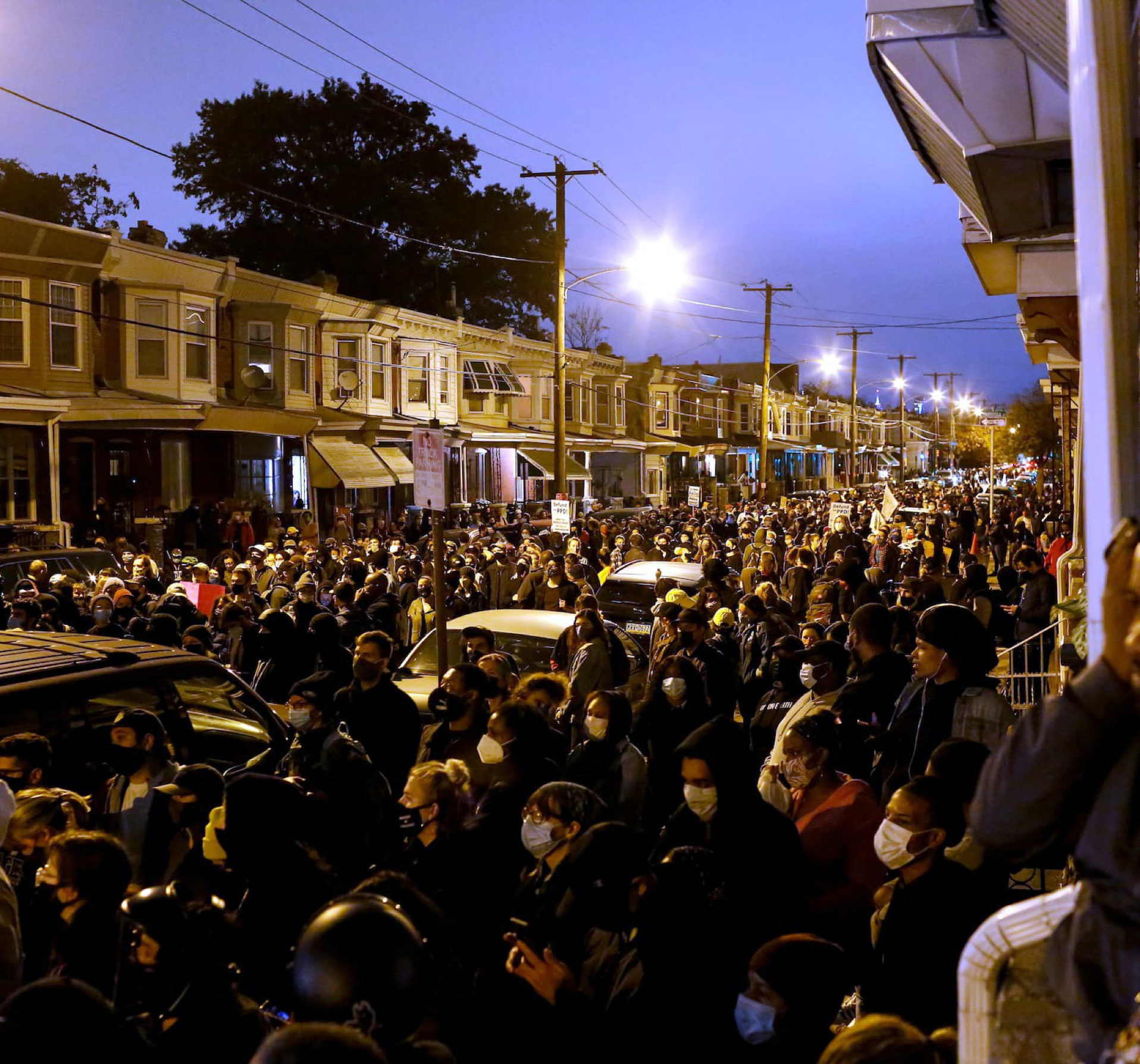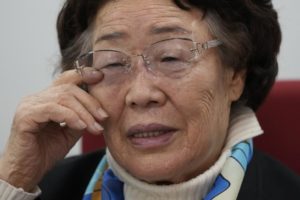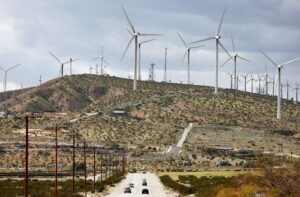( Correction : This story originally misstated the role of the National Guard in responding to the protests. While Pennsylvania Gov. Tom Wolf (D) has authorized the Guard to deploy, no Guard troops have yet gone to Philadelphia, according to the office of Mayor Jim Kenney (D).)
PHILADELPHIA — On the second night of mass demonstrations over the fatal police shooting of a 27-year-old Black man, about 1,000 protesters marched through the streets of West Philadelphia on Tuesday demanding justice for Walter Wallace Jr.
Authorities have faced calls to release more information in the case — including from the police union — and said they had expected more unrest Tuesday night. Police said they were dispatching more officers, while Pennsylvania Gov. Tom Wolf (D) authorized the state’s National Guard to deploy to help police protect property and quell unrest in the state’s largest city.
Wallace’s death Monday set off spasms of anger in Philadelphia, which became the latest city gripped by anguish after a deadly police shooting. It also highlighted the fraught relationship between this community and its police department.
At a community meeting Tuesday evening, residents questioned why police used deadly force, and pleas for healing were mixed with tensions as some in the room condemned city officials for what happened.
Danielle Outlaw, the police commissioner, responded by telling the gathering that “we are not at war with our community; we are of our community.”
Officials have pleaded for patience as they investigate what happened when Wallace was killed. Authorities have released few details about the episode, saying they were still trying to understand what the officers knew when they encountered him and why they opened fire.
On Wednesday, following two nights of unrest, city officials said they would be imposing a curfew beginning at 9 p.m. that night. It was set to last until 6 a.m. Thursday, officials said, with a similar curfew running from 9 p.m. Thursday until the following morning.
At a news briefing Wednesday afternoon, officials repeatedly decried the looting that had occurred the previous night. Outlaw said there were nearly 300 reported incidents of looting and 81 arrests made on Tuesday night, most for burglary.
Outlaw also said officials are hoping to release the 911 call and body camera footage publicly “in the near future,” saying they hoped to play both for Wallace’s family before doing so publicly.
John McNesby, president of the Philadelphia police union, has defended the officers, saying in a statement that they “were aggressively approached by a man wielding a knife.” He also issued a public call Wednesday for the city to release more information from the shooting.
“We’re calling on the city leadership to release the facts of this case,” McNesby said in a video recording. “It’s not hard. It’s cut and dry. Release what you have. Support your officers, back your officers and let’s get a handle on this thing.”
At the community meeting Tuesday, a trauma counselor urged people to take steps to heal. Jamie R. Gauthier, a city council member, said: “I’m heartbroken, I’m sickened. Our entire community mourns his loss.”
During the meeting, state Sen. Anthony Williams showed a video of police shooting a White man, and Wallace’s mother was wailing in the front row. Her family gathered around and escorted her out as she cried, and one person said: “You’ve got a grieving mother here; how dare you show that.”
The demonstrations and looting that unfolded Monday evening and into early Tuesday left shops damaged and at least 30 officers injured, including one hospitalized with a broken leg after being struck by a truck, the police commissioner said.
On Tuesday, police and protesters clashed again, but officers took a more aggressive tack, filling the streets with lines of riot police who stopped marchers and made several arrests earlier in the evening.
Also Tuesday evening, a racially diverse crowd gathered at Malcolm X Park in West Philadelphia, near the neighborhood where Wallace was shot. The group wound through residential streets until their path collided with a line of police officers in riot gear. Protesters chanted directly to the police.
“Who killed Walter Wallace?” they asked. “No justice, no peace! No racist police!”
Wallace died Monday after two Philadelphia police officers shot him multiple times while responding to a call reporting a man with a knife. His family said he suffered from mental health issues, which his doctors had been treating with medication. A lawyer for the family told the Associated Press on Tuesday that Wallace’s relatives had called for an ambulance to take him to the hospital for medical care, but police showed up instead.
A video of the fatal encounter raised questions about why officers approached a man in an apparent mental health crisis with guns drawn and why they did not first try to subdue Wallace with a less-lethal weapon, such as a Taser.
“We’re out here to decimate the system that’s meant to decimate us,” said Mikal Woods, a 24-year-old Black man who lives in the West Philadelphia neighborhood that has been rocked by the shooting and subsequent protests. “They shot that man to kill him. Fourteen times.”
“I’ve been afraid of the police every day of my life,” he added.
Wallace was one of at least 804 people shot and killed by police this year as of Monday, according to The Washington Post’s police shootings database, which tracks such incidents nationwide.
The most popular and interesting stories of the day to keep you in the know. In your inbox, every day.
Mental health issues have been a consistent element of these fatal shootings since The Post began its database in 2015. This year, 1 in 5 fatal shootings by police have involved people who were suffering from mental health issues or in the midst of a crisis.
This recurring pattern has prompted questions about whether police have the training needed to respond to such issues and spurred calls for officials to find different ways to respond.
In Philadelphia on Tuesday, some of the city’s demonstrations remained calm as late evening turned to night. As protesters marched, a truck lighted up with photos of Wallace rolled through a largely peaceful crowd in West Philadelphia. A neon message displayed on its rear doors read: “I don’t hate cops. I hate that cops don’t speak against the killing of Blacks by cops.”
Pascale Vallee, a 34-year-old graduate student studying public health, said the killing of Wallace was “shameful.” She said she saw his death as “the intersection of so many ‘-isms’: racism, ableism.”
“He needed social supports,” she added, “not bullets.”
A large protest also broke out in New York on Tuesday night, as demonstrators gathered in Brooklyn. People shattered windows at several stores, lit fires and sprayed graffiti on a police van, the New York Daily News reported. New York police arrested about 30 people before the protests largely broke up.
As the protests spread out from West Philadelphia into several other parts of the city and grew increasingly volatile late Tuesday, the Philadelphia Police Department issued a request for residents near the unrest to stay home and remain indoors.
“These areas are experiencing widespread demonstrations that have turned violent with looting,” the city’s Office of Emergency Management said in statement on Twitter on Tuesday night.
According to a statement from the Philadelphia Police Department, people in the large crowd began to loot businesses near Castor and Aramingo avenues in North Philadelphia just before 9 p.m.
Helmeted police armed with batons and others with large riot shields took an aggressive posture against demonstrators and media Tuesday night, breaking up large groups with targeted arrests after identifying people accused of throwing bricks and bottles.
Protesters who yelled for the arrested to say their names as they were being detained were met with taunts from police: “His name is ‘caught,’ ” one officer responded. Other officers called demonstrators “motherf—ers” as they shoved them with batons.
By 2:30 a.m. Wednesday, the protests near 52nd Street were broken up by police, who detained and arrested dozens as they marched toward angry crowds. Officers chanted, “Move, back! Move, back!” and repelled rocks, bricks, kicks and shoves with scuffed plastic shields and batons. It is unclear how many arrests were made overnight.
Police said a shooting that injured two teenagers may have been connected to looting near Castor and Aramingo avenues, the Philadelphia Inquirer reported. Philadelphia police did not release any additional details on how the shooting happened, a possible motive or who was involved.
Walter Wallace Sr., the father of the man killed Monday, denounced the looting Tuesday evening. “They’re not helping my family; they’re showing disrespect,” Wallace Sr. told the Inquirer. “Stop this violence and chaos. People have businesses. We all got to eat.”
Tuesday night’s tension between protesters and police is nothing new, said Charles M., a local middle school math teacher who declined to give his last name.
“West Philly and the cops have had a problem for a long time,” he said.
The teacher, who is Black, stood to the side of the crowd, scanning it. “My main reason for being out here is making sure people don’t mess it up,” he said.
He was on the lookout for “agitators,” who he said were generally White people dressed in all black with their faces covered. A cohort meeting this description did later wind through the crowd.
“They’re the ones that spray paint, they’re the ones that throw bricks,” he said. “When you talk with them, engage with them, they split.”
Shepherd and Berman reported from Washington.




